chief executive's Review
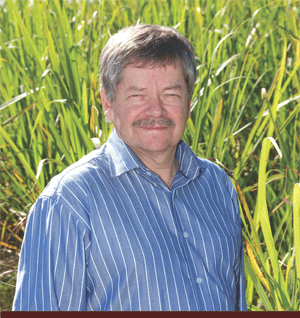
Peter Staude
Chief Executive Officer
The past year continued to be characterised by counteractive factors. Progress towards fully utilising Tongaat Hulett’s installed sugar milling capacity of some 2 million tons per annum was hampered by the severe drought in the 2009/10 growing period in South Africa, coupled with poor growing conditions in Mozambique in the early part of 2010. Tongaat Hulett’s sugar production in South Africa was the lowest in many decades. Exchange rates have been less favourable than in the prior year. Sugar realisations in the past year in the Mozambique local market and on exports from South Africa were constrained. Favourable prices were achieved on exports from Mozambique and Zimbabwe into the European Union and the United States. The 7 800 hectare increase in land under cane, with its corresponding root planting, as well as better expected future yields, crop positioning and improved sugar prices led to an increase in the value recorded for the sugar cane growing crop at the 31 March 2011 year end. The results of the starch operation improved substantially. The sale of development land remained depressed in the current economic climate, while values were maintained.
Tongaat Hulett continued to make progress in capitalising on its strategic platform.
- The predominant short term focus of the business continues to be on increasing cane supply which, together with improving cane to sugar ratios, should move Tongaat Hulett’s production to in excess of 2 million tons of sugar per annum compared to the 1 million tons produced in recent seasons.Approximately 90 percent of sugar milling and overhead costs are fixed and the increased sugar volumes will lead to a substantial reduction in unit costs of production.
- Weather conditions will continue to have an impact and, at the same time, the key issues remain getting the appropriate hectares under cane, uplifting yields to the targeted levels and establishing the right balance between cane from Tongaat Hulett estates and that from private farmers linked to the mills.
- The strategy to increase cane supply is focused on growing Tongaat Hulett’s influence in cane development through leasing land, working with private farmers and collaborating with government to rehabilitate cane supply on its land and land reform farms that have gone out of cane.
- In South Africa, during the 12 months to 31 March 2011, 5 606 hectares of new cane was planted, which follows the
4 090 hectares planted in the 2009/10 season. This intervention was primarily driven through planting initiatives on communal land that involved seed cane subsidies or through Project Vuselela (revival in Zulu) as well as leases and farm management contracts on commercial farms. Further expansions of the area under cane of at least 8 000 hectares are planned for the 2011/12 planting period, with the land under sugar cane supplying Tongaat Hulett mills targeted to reach approximately 159 000 hectares by the 2014/15 season. A key factor in achieving this is ensuring that there is no backlog in root replacement. In the 2010/11 season the average yield was 36,3 tons cane per hectare, partly as a result of the drought and also due to poor farming practices. The target is to increase yields to 54 tons cane per hectare harvested by the 2014/15 season, assuming normal weather conditions. - Tongaat Hulett has been appointed as a strategic partner to rehabilitate land reform beneficiary farms within its cane catchment area in South Africa. In terms of the partnership agreement signed by the National Department of Rural Development and Land Reform, the Government will contribute some R70 million to rehabilitate approximately 57 land reform farms.
- In Zimbabwe, Tongaat Hulett has embarked on a comprehensive private farmer rehabilitation programme to increase sugar cane production substantially over the next three years to more than 1,4 million tons per year by the 2014/15 season on 15 880 hectares that are privately farmed. In the event that the private farmer segment had achieved the cane yields possible from their estates, US$77 million would have been paid to them based on the sugar price relevant for the period to 31 March 2011. An accelerated private farmer cane replanting program under the direction of a full time project management team has been initiated to replant some 4 000 hectares per year over the next three years. This together with support on fertilizer supply, pest and weed control and good farming practices should result in yields increasing from 47 tons cane per hectare in the 2010/11 season to 99,9 tons cane per hectare in the 2014/15 season.
- In addition to Tongaat Hulett’s initiatives in this area, the first two tranches of the EU Adaptation Funding Programme amounting to €9,2 million have been applied to rehabilitate infrastructure and the replanting of 1 200 hectares of private farmer cane in Zimbabwe. A third tranche of €13,8 million will fund carried over shortfalls and further rehabilitate infrastructure over the next 12 months.
- The 21 800 hectares harvested in Mozambique at an average of 72,9 tons cane per hectare in the 2010/11 season is scheduled to grow to 26 848 hectares with a cane yield of 93,6 tons cane per hectare in the 2014/15 season.
- Over and above the increase in land under cane, management continues to focus on optimising crop positioning so that sugar cane is harvested every 12 to 13 months thereby maximising sugar yields. Additional focus on key mill performance measures including Time Efficiency and Overall Sugar Recovery Rates will ensure that operations progress to consistently perform at world class levels.
- In South Africa, during the 12 months to 31 March 2011, 5 606 hectares of new cane was planted, which follows the
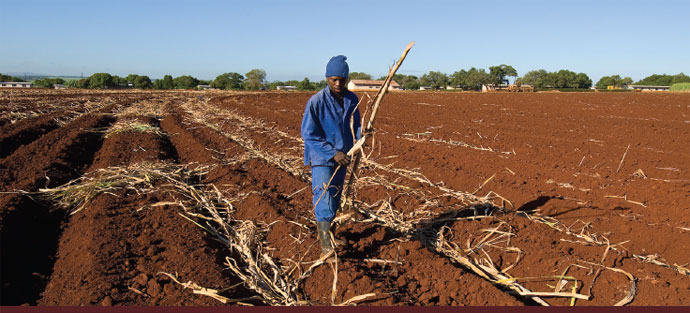
- The past year has seen increased debate around indigenisation in Zimbabwe. Tongaat Hulett understands the fact that indigenous people wish to be empowered within their own economy. Ninety-nine percent of the management and employees at the operations in Zimbabwe are of Zimbabwean descent. In the ongoing discussions, Tongaat Hulett has recommended that the focus be placed on further developing indigenous Zimbabwean farmers. In the 2010/11 season, 569 farmers delivered 413 835 tons sugar cane from 8 805 harvested hectares of land to the Hippo Valley and Triangle sugar mills. Tongaat Hulett has targeted that by the 2014/15 season some 865 farmers will deliver 1,4 million tons sugar cane to its operations from 15 880 hectares.
- The regulatory framework underpinning the South African sugar industry is under review. The emergence of renewable electricity and ethanol opportunities and the move to intra-regional sugar flows will increasingly play a bigger role in defining the industry.
- A review of regional prices reveals that in addition to having had the lowest export realisations in recent years, the South African domestic market prices remain the lowest in the region, with the exception of the 2010/11 realisations in Mozambique following the significant devaluation of the Metical. The structural shortfall in supply to the EU market offers Tongaat Hulett and the region the opportunity to optimise sugar flows within the Southern African Development Community to its and the region’s benefit.
- The company’s sugar technology leadership continued during the year with milling performance exceeding industry benchmarks measured in terms of crystal sugar recovery. The top two South African industry positions were taken by Tongaat Hulett mills. The refinery continued its upward trend in capacity utilisation, achieving an all-time production record that resulted in refined sugar production increasing to 628 000 tons in 2010/11 (2009/10: 575 000 tons).
- Following the progress made at the Copenhagen and Cancun conferences, South Africa, as the host nation of COP 17, will face increased pressure to show tangible progress in its objective to reduce the country’s CO2 emissions.
- Tongaat Hulett is currently engaging with the South African and Mozambique governments with regard to the development of the policy framework to enable the rapid development of the bio-fuel industry in the region.
- The structural changes taking place in international agricultural commodity markets have resulted in the improved competitiveness of South African maize and Tongaat Hulett’s starch operations, which can increase production, from installed milling capacity, by a further 20 percent.
- Operational performance in 2010/11 improved at all plants against key benchmarks with an estimated benefit of
R26 million. - The local maize price is currently trading close to, or below the world price, which has recently been trading in a range between US$260 - US$300 per ton compared to its long-term mean before the introduction of ethanol in the USA of US$80 - US$100.
- Exports are growing and the trading footprint in the SADC region is being developed. Increasing exports to utilise the existing milling capacity would have an EBIT impact of more than R60 million per annum.
- Operational performance in 2010/11 improved at all plants against key benchmarks with an estimated benefit of
- The Durban region is currently short of serviced industrial land and, with a growing logistics sector, the opportunity is increasing for the establishment of an internationally competitive aerotropolis in the region surrounding the King Shaka International Airport and Dube Trade Port.
- The Environmental Impact Assessment (EIA) for Cornubia South, which includes the Cornubia industrial and business estate, is currently underway. The area is a national priority project and is eThekwini’s and KwaZulu-Natal’s first sustainable integrated human settlement. The Cornubia industrial and business estate comprising 203 gross hectares (103 developable hectares) and 85 platform hectares is scheduled to commence selling in February/March 2012.
- The EIA for the Inyaninga industrial and commercial business park node comprising 707 gross hectares (550 developable hectares) is in progress and Tongaat Hulett is pursuing bulk land sales or land conversion partnership agreements in this regard.
- Market conditions in most sectors have been muted. Tongaat Hulett continues to actively pursue bulk land sales and land conversion partnership agreements with both public and private sector entities, for example the Sibaya landholding near eMdloti is being marketed as an internationally significant development and investment opportunity.
- The creation of a workplace that is free from injuries and fatalities is a high priority in the business. Operations continue to focus on reducing or eliminating the inherent risks that are present in the operations, coupled with ongoing attention to human behaviour. The LTIFR for the year to 31 March 2011 was 0,10 (LTIFR 2010 0,097) and when viewed against an LTIFR of 1,27 in 2003, there has been a significant improvement in the company’s safety performance. Regrettably, four fatalities occurred during the reporting period. In the first incident, an irrigation operator was struck by a goods train at the Triangle operation in Zimbabwe. Three people were fatally injured in motor vehicle accidents, two in Zimbabwe and one in Mozambique.
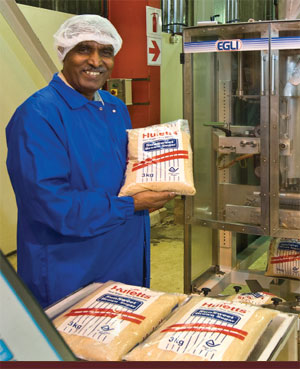
FINANCIAL AND OPERATIONS REVIEW
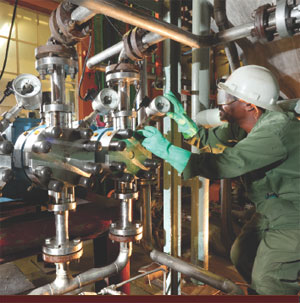
Revenue increased by 10 percent to R9,7 billion for the twelve months ended 31 March 2011 and profit from operations was R1,338 billion compared to the R1,500 billion earned in the previous comparative twelve months. Headline earnings of R806 million were recorded, compared to R815 million for the twelve months to 31 March 2010.
Profit from the starch operations increased by 21 percent to R303 million from R251 million in the prior year. A margin increase was generated by improvements in manufacturing efficiencies, lower maize costs and higher international starch prices. This was partially offset by a firmer Rand and lower co-product prices. Higher international maize prices combined with favourable agricultural conditions resulted in a third consecutive annual South African maize surplus and local maize prices which traded close to or below international prices for most of the year.
MAIZE PROCUREMENT
The final maize crop estimate for the 2009/10 season amounted to 12,8 million tons (2008/9: 12,0 million tons). Despite an expected reduction in the area of maize planted in South Africa to 2,38 million hectares (2009/10: 2,74 million hectares) during the current summer crop production season, reasonable growing conditions are expected to result in a crop of 11,0 million tons which will ensure that supply exceeds local demand for a fourth consecutive season. This will maintain Tongaat Hulett’s competitive position. South African maize prices continue to trade at levels of US$40 - US$50 below the CBOT price for the old season maize and US$15 - US$35 for the new season crop.
Physical maize requirements of non-genetically modified maize for Tongaat Hulett continue to be secured through a combination of contracting directly with farmers and contracting for delivery with selected grain traders. The physical supply for the remainder of the season to June 2011, and the requirements for the period July 2011 to May 2012 have been contracted.
Maize pricing is delinked from the physical supply utilising either a toll manufacturing arrangement or a back-to-back pricing approach. Both approaches eliminate the risk of profit volatility that could arise from valuation adjustments on maize. The back-to-back method, however, does not eliminate the profit volatility which arises due to the relative prices of South African maize compared to international prices. The use of a third pricing mechanism, which secures the local price of maize at a level relative to the international price, was increased during the season. Utilising a combination of the above three methods has resulted in the maize price on approximately 71 percent of the 2011/12 financial period’s local maize requirements being hedged at levels close to the international price of maize at March 2011.
LOCAL MARKET
Domestic volumes for starch and glucose for the financial year increased by 2,6 percent as the economy continued to recover from the global recession. Volume growth of 11,8 percent was recorded within the coffee and creamer sector as consumer demand continued to increase and additional production capacity was commissioned. The confectionary sector recorded annual growth of 8,1 percent due to new entrants in the market as well as expansion projects undertaken by customers. Trials for the replacement of imported starch in the paper sector commenced in the last quarter of 2010 with the estimated annual volumes amounting to 12 500 tons.
New product development for value added starches for both the domestic and export markets continued during 2011, with sales of starch-based adhesives equating to 1 388 tons and additional exports to Kenya and Malawi expected to commence in the second half of 2011. The toll manufacturing of modified food starches in Thailand, which will allow for expansion into the food market, continued during the period.
EXPORT MARKETS
Export volumes increased by 30 percent to 48 590 tons supported by the competitive South African maize prices and improvements in local production that enhanced supply chain reliability. The key markets that reflected the growth were the Australian, Nigerian and Zimbabwean markets. Tongaat Hulett is continuing to develop its trading footprint in the SADC region and a key focus in the current financial period will be on increasing exports in this region.
STARCH MANUFACTURING EFFICIENCIES
The high level of management focus on all areas of manufacturing efficiency has yielded positive results and significant cost reductions have been realised leading to an improvement in operating margins. Further improvements are expected in the forthcoming period with the commissioning of new equipment in the first quarter of the financial period.
The use of bunker silo facilities at the Kliprivier and Meyerton mills continued during the period. These silos assist in reducing storage and handling costs and their use is one of a number of initiatives being pursued in order to improve grain handling at the operations.
The Zimbabwe sugar operations increased production by 29 percent to 333 000 tons from 258 000 tons in the prior year. Initiatives are underway with farmers to increase the hectares under cane, as well as to improve yields and optimise cane age on the company estates, in order to grow cane supply. The opportunity exists for a further 80% growth in sugar production up to the installed milling capacity of 600 000 tons per annum and a reduction in the unit cost of production. The extended mill refurbishment programme during the previous off-season resulted in a late start at Hippo Valley Estates, consequently not all the cane could be crushed by the end of the season. The quantum of the increase in the value of growing crops in 2010/11 was lower than that of 2009/10 due to the re-establishment of the sugar cane crop and a greater price recovery in 2009/10. The profit from the Zimbabwe sugar operations was R454 million (US$ 63 million) compared to R518 million (US$ 66 million) in the prior year.
SUGAR CROP AND OPERATIONAL PERFORMANCE
Tongaat Hulett’s Zimbabwe operations accounted for 2,15 million tons of sugar cane crushed whilst private farmers delivered 413 835 tons sugar cane during the 2010/11 season. Sugar cane yields were adversely impacted by sporadic rainfall and intermittent power availability for irrigation during the peak growth period from November 2009 to February 2010. During the 2010/11 season, the Zimbabwe operations signed a preferential power supply agreement with the local power producer, in order to ensure continued electricity supply for irrigation purposes.
From a mill performance perspective, the company invested some US$30 million in order to restore milling operations to their installed capacity. The refurbishment program at Hippo Valley mill started in the 2009/10 season and was completed in the 2010/11 season. The program was aimed at restoring the mechanical soundness and sugar recovery efficiencies to installed capacity following years of minimal maintenance prior to the return to a more normal trading environment in 2009.
CREATING SUCCESSFUL RURAL COMMUNITIES
Tongaat Hulett operations play a significant role in the socio-economic development of communities surrounding the businesses in the lowveld region and employment opportunities are provided for some 17 800 employees. Social services to improve health, education, environment and social stability continue to be a key component of the Zimbabwe
operations’ commitment to the development of successful rural communities.
In Mozambique, sugar production increased by 24 percent to 166 000 tons, as the operations progress towards the recently expanded capacity of more than 300 000 tons per annum. Volumes were lower than expected as a result of crop positioning and weather conditions, which led to lower cane yields per hectare harvested and 18 percent less sugar extracted from the cane than expected, particularly in the latter part of the year. Consequently, some sugar cane originally targeted for milling in the 2010/11 season was carried over and will be milled early in the 2011/12 season. Following the rapid depreciation of the Metical during the year, domestic market prices lagged regional prices for a large portion of the year and had a negative impact on operating profit of some R120 million. In addition, the fixed cost nature of the business resulted in high costs per ton of sugar produced, with the cane expansion still being in the ramp-up phase. Profit from operations was R135 million (Metical
628 million) compared to R141 million (Metical 521 million) in the prior year.

SUGAR CROP AND OPERATIONAL PERFORMANCE
During the 2010/11 season, the cultivated area of harvested sugar cane, for delivery to the Xinavane and Mafambisse mills, increased to 21 800 hectares (2009/10: 18 415 hectares). Sugar production in 2010/11 comprised 121 000 tons (2009/10:
89 000 tons) at Xinavane and 45 000 tons (2009/10: 45 000 tons) at Mafambisse.
Production of sugar was adversely affected by a number of factors, including unfavourable weather conditions. The unseasonal rainfall that occurred at Mafambisse from February to May 2010 when 46 percent more than Long Term Mean was recorded on average per month over the period, together with low sunshine hours, had a significant impact on crop growth and cane quality, which resulted in low recoveries. At Xinavane, reliability of power supply for irrigation purposes proved to have a negative impact on the crop and this was particularly evident in sugar cane harvested at the end of the milling season.
Following the expansion and project activities of the past two periods, the current focus continues to be on improving the quantum and quality of cane supplies to the mills. In order to address the power supply concerns at Xinavane, a 20 MVA sub-station was commissioned at the end of February 2011. Various initiatives have been implemented during the past two seasons to improve cane yields and ensure that the estates’ yield potential is achieved. These include streamlining the management structure of the agricultural department, improving field layouts and drainage, gapping up of poorly germinated areas and irrigation system maintenance and operation.
The South African sugar milling, refining and agriculture operations made a loss of R7 million for the year compared to a profit in the prior year of R136 million. The extreme drought conditions in KwaZulu-Natal in the past season led to a reduction in the sugar crop and higher costs per ton of sugar produced. Sugar production reduced to 445 000 tons (2009/10: 564 000 tons). Domestic sales volumes grew by 3,2 percent. In terms of the South African sugar industry legislated regulations,
83 percent of the sales in the 2010/11 season were deemed to be local and 17 percent were recognised and valued as exports. The export realisations did not fully reflect the higher world prices and were limited by the reduction in production. The average realisation for these raw sugar exports was R3 272 per ton (2009/10: R3 070 per ton), including a sugar price of 18,5 US c/lb at an average exchange rate of R7,62/US$, which included a quota shipment to the US at 28,58 US c/lb.
SUGAR CROP
The South African sugar mills experienced a shortage of cane supply, predominantly due to a prolonged drought lasting from January 2010 to September 2010. The South African Sugar industry completed a comprehensive review of the small scale farmers actually delivering sugar cane and consequently reduced the hectares under cane supplying Tongaat Hulett mills by some 10 000 hectares. An additional 4 090 hectares were planted in the 2009/10 season resulting in the area under cane at the start of the season being 123 907 hectares.
The downstream sugar value added activities contributed R241 million to profit (2009/10: R200 million). This includes Voermol animal feeds, South African refined exports, regional marketing, sales, packing and distribution activities. During the 2010/11 season, the packing operations in Botswana and Namibia sold 49 000 and 55 000 tons of sugar in their respective markets where in both instances the brands in these operations are the market leaders.
In Swaziland, the Tambankulu sugar estate produced a raw sugar equivalent of 54 000 tons (2009/10: 54 000 tons). The Swaziland sugar industry’s EU export realisations were lower than last year. The increase recorded in the value of the sugar cane in 2010/11 was below the increase of 2009/10. Operating profit reduced to R17 million (2009/10: R51 million).
Land and property development activity continues to focus primarily on the areas north and west of Durban in anticipation of demand in the near term from urban growth. Good progress is being made, working with all spheres of government, on adding value for all stakeholders through processes of preparing for the conversion of agricultural land to optimal land usage and accelerated socio-economic development at the appropriate time. In the present economic conditions the sale of development land across most sectors remains depressed and few hectares are being converted to development. Revenue in the past year was generated mainly from sales in the Cornubia, Umhlanga Ridgeside and Izinga areas, together with a benefit and associated land sale for the golf course at Zimbali Lakes, which is currently being constructed by Tongaat Hulett’s joint venture partner. During this period, 144 developable hectares (209 gross hectares) were sold. Operating profit from land conversion and development amounted to R166 million (2009/10: R194 million) with a further R23 million in capital profits (2009/10: R52 million) being realised.
LAND SALES
The sale of 100 developable hectares of land at Cornubia South increased the extent of land owned by eThekwini to 369 developable hectares. Tongaat Hulett owns 345 developable hectares and the EIA for this area is currently underway.
The sale of land in Umhlanga Ridgeside during the reporting period re-confirmed net cash inflows of R9,9 million per developable hectare, when prices of R3 000 per bulk m2 were achieved and in Umhlanga Town Centre net cash inflows of R16,4 million per developable hectare were achieved when record prices of R3 610 per bulk m2 were realised. In addition, land sales at River Horse Valley realised R1 750 per m2 of platform when R6,2 million per developable hectare was achieved.
The centrally accounted and consolidation items, in profit from operations, included a gain of R130 million (2009/10: R82 million) on the recognition of an unconditional entitlement to an employer surplus account allocation, which is funding an employer contribution holiday in the Tongaat Hulett pension fund.
Tongaat Hulett’s operating profit has increased to R1,606 billion from R1,535 billion in the prior year. It includes an amount of R288 million, relating to the recognition of an accounting surplus in the South African defined benefit pension fund, as required by international financial reporting standards (IFRS), following the formal splitting of the fund between Tongaat Hulett and Hulamin.
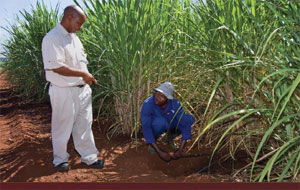
Finance costs for the year increased to R472 million from
R365 million in the prior year. The capitalisation of interest on the Mozambique expansion project ended in the prior year, with the commissioning having been completed.
Cash inflow from operations, before a working capital absorption and tax payments, was R1,005 billion for the year. The last three years have seen significant capital expenditure on the Mozambique expansion and cash being absorbed in the establishment of the expanded cane crops, the replanting of sugar cane and mill refurbishment in Zimbabwe. Tongaat Hulett’s net debt at the end of the year was R3,925 billion (2009/10: R3,040 billion).
The Board declared a final dividend of 140 cents per share, which brings the total annual dividend to 250 cents per share, compared to 275 cents per share in the fifteen month prior period.
CONCLUSION
OUTLOOK
The large South African maize harvest in 2010 and the high maize stock levels from the previous two seasons should maintain local maize prices close to world prices and contribute to the competitiveness of the starch operation. Higher international starch prices are countering the impact of the exchange rate.
Tongaat Hulett expects to make further progress in growing sugar production towards the target of doubling the 2010/11 production, utilising the available milling capacity, with a simultaneous reduction in unit costs. Production in Mozambique is expected to increase by more than 50 percent in the 2011/12 season to between 250 000 and 270 000 tons of sugar, with an increase in hectares harvested, higher cane yields and improved sugar extraction from cane anticipated. Zimbabwe sugar production in the 2011/12 season is expected to increase to between 360 000 and 380 000 tons of sugar, with better cane age and yields on a similar number of hectares being harvested. In South Africa, sugar production is expected to increase in the 2011/12 season, notwithstanding the variable growing conditions at the beginning of the year, as the cane recovers from the drought of 2010. The strategy to increase cane supply in South Africa is focused on increasing Tongaat Hulett’s influence in cane development through leasing land and collaborating with government to rehabilitate cane supply on its land and land reform farms that have gone out of cane. Tongaat Hulett expects to have new sugar cane planted on more than 8 000 hectares in South Africa in 2011/12, following the additional 9 696 hectares planted over the past two years.
Pricing of raw sugar into the European Union is reflective of demand exceeding supply. Regional sugar prices at the start of the new season are above those of last year, in line with current global sugar dynamics.
Considerable growth in profit from operations is expected in the year ahead. Tongaat Hulett’s financial results remain sensitive to movements in the Rand, US dollar, Euro and Mozambique Metical. These impact on the revenue streams, costs incurred and the conversion of profits into Rands.
Agricultural land conversion and development activity is currently focused on development, partnership and bulk sale opportunities in the north and west of Durban, including industrial and business park land adjacent to the new international airport and at Cornubia. Industrial land in Durban/eThekwini remains in short supply. Tongaat Hulett has 13 654 gross hectares available for conversion to development over time in South Africa.
Renewable energy, both electricity generation and ethanol production from sugar cane, provides substantial future opportunities.
ACKNOWLEDGMENTS
I wish to pay tribute to the more than 42 000 employees of Tongaat Hulett and thank them for their continuing dedication and commitment to the achievement of the business’ strategic objectives. Our significant agricultural and agri-processing footprint in the rural areas of Mozambique, Zimbabwe and the North Coast of KwaZulu-Natal present us with the opportunity to continue our contribution to the ongoing development of successful rural communities. Working together with farmers, communities and governments, we have established a competitive platform that will stand us in good stead into the future.
Our appreciation to extended to Russell Stevens and Vincent Maphai for the contributions made, during their time on the Board. The support and guidance that we have received from the Board is highly valued. Tongaat Hulett is fortunate to have a Chairman of JB Magwaza’s calibre. His wise counsel, calmness and insight into socio-economic issues is particularly appreciated.

PETER STAUDE
CHIEF EXECUTIVE OFFICER
Amanzimnyama
Tongaat, KwaZulu-Natal
26 May 2011




